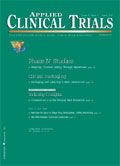A Call for More Open Collaboration
Applied Clinical Trials
Scientific discovery is, by its very nature, plagued by a lag between concept development and the acquisition of the tools necessary to fully explore a new technology's application.
Scientific discovery is, by its very nature, plagued by a lag between concept development and the acquisition of the tools necessary to fully explore a new technology's application. The collaboration and sharing of development technologies and tools proposed in the Critical Path Initiative provides an excellent framework for decreasing this lag. In concept, therefore, the Initiative holds great promise. In application, however, several impediments to success need to be addressed.

Robin Newman
The Critical Path Initiative is not a new concept. Throughout the United States, incubator groups and organizations promote sharing of ideas and collaboration toward development of new products, methods, and technologies. What makes this Initiative unique is its scope and the fact that it is being driven by the government rather than by scientists and engineers in the field. This top-down, ombudsman approach to encouraging collaboration should mitigate some of the inherent struggle between intellectual property rights and the need to move all technologies forward. For pharmaceutical development, this may also help to level the playing field for the smaller under-funded biotechnology firms that do not have the internal resources to support extended research time lines.
For the medical device manufacturer, however, the Initiative presents a dilemma. Technology advances rapidly. This may mean that by the time a device manufacturer successfully navigates the approval process, their technology is becoming obsolete. This argues in favor of collaborating with other manufacturers to speed up discovery and review. On the other hand, the medical device industry has a unique problem, in that they tend to use up their target population. Unlike a drug, the device recipient usually needs only one or two "doses" to achieve cure or maximum benefit. For this reason, being first to market is essential, and sharing innovative technology is counterintuitive to this goal.
Moving past traditions
A second challenge the Initiative presents involves traditions. The FDA and the industry have committed to a number of gold standards, which may restrict or inhibit the development and application of new technology. For example, at an FDA panel meeting during the summer of 2004, two panel members suggested that the sponsor should have designed the trial with a sham control. For this device, a sham control would have required that a highly symptomatic patient undergo several hours of conscious sedation and some discomfort only to receive no treatment. Although one panel member commented that there were significant ethical considerations in a study of this design, two panel members insisted that this was the traditional gold standard and refused to vote to approve based upon this assertion. The "aggressive, collaborative research effort to create a new generation of performance standards," discussed by Janet Woodcock, must start with a shift in attitudes.

Finding ways to move innovative technologies out to the public in a more effective and less costly manner is essential. As an owner of a CRO, I know that the best and most interesting companies with whom I work take their public stewardship obligations as seriously as their stewardship to their shareholders. This balance of commitment is essential to encourage effective collaboration.
For the Critical Path Initiative to be successful, a similar balance must be achieved on a much broader scale. We have to begin with a public education initiative focused on reasonable expectations. The current risk-averse attitude is the enemy of speed and innovation. The public, our courts and our representatives need to acknowledge the price we pay when we accept nothing less than a risk-free society. In addition, protections need to be in place for first-on-the-block technologies and new companies to encourage sharing and protect market position. Finally, to keep the Initiative alive, we have to produce excellent work. The trust required to get the public and industry to work together can be easily broken if clinical research professionals don't do everything possible to enhance the quality, reliability and ethics of research practices.
In anticipation of future guidance, standards and tools, industry professionals have begun to take stock. A CRO enjoys the ability to look into a variety of companies and learn from each of them. The side-by-side comparison opportunity this affords allows us to identify and select the best practices for our own processes. The more experience the CRO has with any product type or therapeutic indication, the more likely the CRO is aware of creative methods, research tools or technical solutions that could be applied. Current practices, however, make it very difficult, and in many cases, ethically impossible for the CRO to share this knowledge. It is my sincere hope that the Initiative will address this problem and provide a window through which all stakeholders can benefit from more open collaboration.

FDA Fast Tracks Johnson & Johnson’s Nipocalimab for Fetal Neonatal Alloimmune Thrombocytopenia
March 27th 2024Johnson & Johnson is moving forward with a pair of Phase III trials of nipocalimab to reduce the risk of fetal neonatal alloimmune thrombocytopenia in alloimmunized pregnant patients.
Citius Pharmaceuticals Resubmits BLA to FDA for Lymphir to Treat Cutaneous T-Cell Lymphoma
March 19th 2024Pivotal Phase III Study 302 trial data show an objective response rate of 36.2% based on an independent review committee assessment in the treatment of relapsed/refractory cutaneous T-cell lymphoma.